Ask User for a Range
VBA provides a number of ways to interact with users. MsgBox lets you send a message to a user, and get a simple response (yes/no or okay/cancel) in return. InputBox lets you ask a user to input some information. And you can design a whole UserForm as a custom dialog.
We will use an InputBox to get a range from our user. There are two kinds of InputBox: regular InputBox that accepts text input from the user, and Application.InputBox, which lets you require a certain type of information from the user. Since we need a range, we’ll use Application.InputBox. The required syntax is:
Function InputBox(Prompt As String, [Title], [Default], _[Left], [Top], [HelpFile], [HelpContextID], [Type])
You supply a Prompt to tell the user what you need, and optionally a Title for the InputBox and a Default value. Left and Top position the InputBox but haven’t worked in recent memory. HelpFile and HelpContextID are used if you have help content for the InputBox. Finally, Type describes the type of data you want; for our purposes, type 8 is used for a range.
Here is a simple VBA procedure that uses Application.InputBox. It uses simple prompt, title, and default arguments, plus the 8 for range, and the in between arguments are left blank. When a range is returned, those cells are filled red.
Sub GetUserRange1()
Dim UserRange As Range
Set UserRange = Application.InputBox("Prompt", "Title", "$A$1", , , , , 8)
UserRange.Interior.Color = vbRed
End Sub
When the code runs, here is how it looks. The default range is highlighted with a dark dashed outline.

When another range is selected, its address appears in the InputBox, and the new range is highlighted a dark dashed outline.
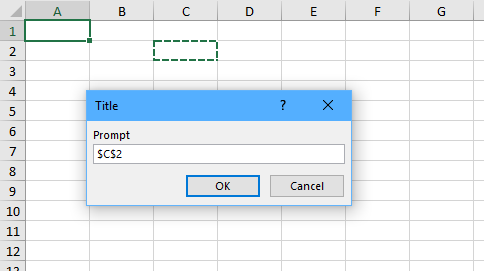
When we then click OK, the selected cell is filled red.
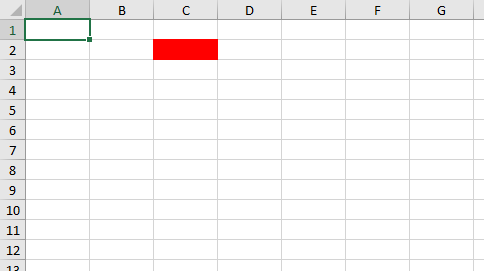
If we try to enter anything that isn’t a range, we get a warning.
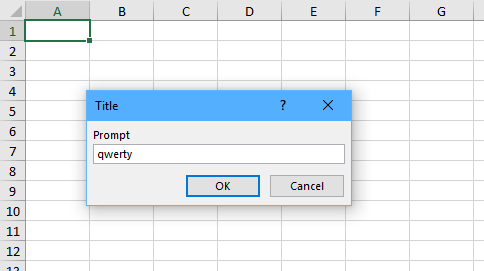
If we give up and hit cancel, we get a run time error. The statement calling InputBox is highlighted.

The warning is fine, but we don’t want to saddle our poor user with the run time error, so we will make a minor modification to the code. Actually, two modifications. First, we wrap the call to InputBox in On Error Resume Next and On Error GoTo 0. Then, if the user has canceled, UserRange will not have been assigned, so it is Nothing, and if this is the case, we’ll bail out before trying to format a nonexistent range, which would lead to another error.
Sub GetUserRange2()
Dim UserRange As Range
On Error Resume Next
Set UserRange = Application.InputBox("Prompt", "Title", "$A$1", , , , , 8)
On Error GoTo 0
If UserRange Is Nothing Then Exit Sub
UserRange.Interior.Color = vbRed
End Sub
Execution exits the sub above in two places, either Exit Sub if UserRange Is Nothing or End Sub at the end. If you have a bit of OCD like I do, you’d prefer the code to always exit at one place, so I usually use this structure instead:
Sub GetUserRange2A()
Dim UserRange As Range
On Error Resume Next
Set UserRange = Application.InputBox("Prompt", "Title", "$A$1", , , , , 8)
On Error GoTo 0
If Not UserRange Is Nothing Then
UserRange.Interior.Color = vbRed
End If
End Sub
Let’s punch up the code with a few text variables, and allow for a smart default range (or you can omit the default to leave out blank if that makes more sense).
Sub GetUserRange3()
Dim Prompt As String
Prompt = "Select a Range"
Dim Title As String
Title = "Select Range"
Dim Default As String
Default = "$A$1"
If TypeName(Selection) = "Range" Then
Default = Selection.Address(True, True)
End If
Dim UserRange As Range
On Error Resume Next
Set UserRange = Application.InputBox(Prompt, Title, Default, , , , , 8)
On Error GoTo 0
If Not UserRange Is Nothing Then
UserRange.Interior.Color = vbRed
End If
End Sub
So now that we know how to get a range from the user, let’s put it to better use than just formatting a range to have a red background.
Select Range and Assign Series Names
In this example, we’ll ask the user for a range containing series names, and we’ll apply the range to the active chart’s series one by one, until we run out of series in the chart or cells in the selected range.
Since we’re working on the active chart, the user must select a chart before running the code. We’ll use this structure to make sure there is an active chart:
Sub DoSomethingToActiveChart()
If ActiveChart Is Nothing Then
MsgBox "Select a chart and try again.", vbExclamation, "No Chart Selected"
Else
' do our thing here
End If
End Sub
Often I just bail out if there’s no active chart, but it’s nice to let the user know why nothing happened when they clicked a button.
In the procedure below, we check first for an active chart, then we ask for a range containing series names. Then we make sure the range is a single row or column (not strictly necessary, but otherwise it gets complicated), and step through the series of the chart, using each cell in the range as the title of the series.
Sub SelectRangeWithSeriesNames()
If ActiveChart Is Nothing Then
MsgBox "Select a chart and try again.", vbExclamation, "No Chart Selected"
Else
Dim Prompt As String
Prompt = "Select a range that contains series names for the active chart."
Dim Title As String
Title = "Select Series Names"
Dim SeriesNameRange As Range
On Error Resume Next
Set SeriesNameRange = Application.InputBox(Prompt, Title, , , , , , 8)
On Error GoTo 0
If Not SeriesNameRange Is Nothing Then
If SeriesNameRange.Rows.Count = 1 Or SeriesNameRange.Columns.Count = 1 Then
With ActiveChart
Dim iSrs As Long
For iSrs = 1 To .SeriesCollection.Count
If iSrs <= SeriesNameRange.Cells.Count Then
.SeriesCollection(iSrs).Name = _
"=" & SeriesNameRange.Cells(iSrs).Address(, , , True)
End If
Next
End With
Else
MsgBox "Select a range with one row or one column", vbExclamation, _
"Must be One Row or Column"
End If
End If
End If
End Sub
Here is a chart. The highlighted data range shows that the Y values are in C5:E10, and the category labels (X values) in B5:B10, but no series names are highlighted. The series names Series1 etc. in the legend also indicate that no series names have been specified.
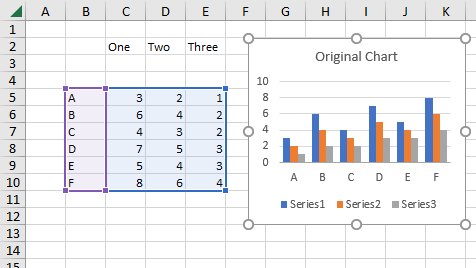
Let’s use the labels in C2:E2 for series names. Run the code: the InputBox is waiting for a range to be selected.
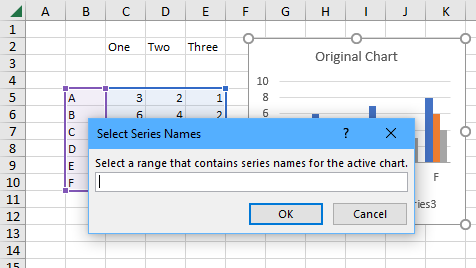
Select a range: it is highlighted with a dark dashed outline.
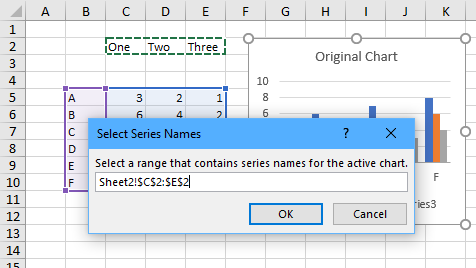
Click OK and the selected range is now highlighted as the series names, and the chart legend shows these labels as series names.
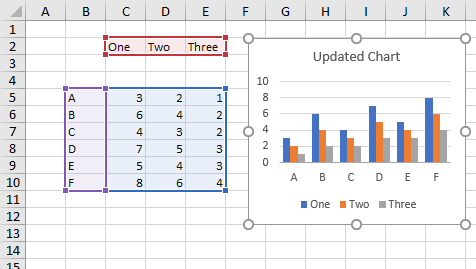
The above procedure can be used to assign series names (legend entries) for a chart that has none, or to replace the existing names (entries) in a chart that already has them.
If there are not enough cells in the selected range, some series do not get new names assigned. If there are more cells than series, the code ignores the excess cells.
Select Range and Assign Categories
In much the same way, we can ask a user for a range containing category labels (X axis values) to assign to a chart.
Sub SelectRangeWithCategoryLabels()
If ActiveChart Is Nothing Then
MsgBox "Select a chart and try again.", vbExclamation, "No Chart Selected"
Else
Dim Prompt As String
Prompt = "Select a range that contains category labels for the active chart."
Dim Title As String
Title = "Select Category Labels"
Dim CategoryLabelRange As Range
On Error Resume Next
Set CategoryLabelRange = Application.InputBox(Prompt, Title, , , , , , 8)
On Error GoTo 0
If Not CategoryLabelRange Is Nothing Then
If CategoryLabelRange.Rows.Count = 1 Or CategoryLabelRange.Columns.Count = 1 Then
With ActiveChart
If CategoryLabelRange.Cells.Count = .SeriesCollection(1).Points.Count Then
.SeriesCollection(1).XValues = CategoryLabelRange
Else
MsgBox "Select a range with the correct number of points.", vbExclamation, _
"Wrong Number of Points"
End If
End With
Else
MsgBox "Select a range with one row or one column", vbExclamation, _
"Must be One Row or Column"
End If
End If
End If
End Sub
The above procedure can be used to assign category labels (X axis values) for a chart that has none, or to replace the existing labels in a chart that already has them.
The selected range must have one row and multiple columns or one column and multiple rows. (In some cases, a chart can have category labels that use multiple rows/columns, but that is a lot more complicated than needed for this example.) If this condition is not met, the code tells the user to try again.
Here is a chart. The highlighted data range shows that the Y values are in D3:F8, and the series names in D2:F2, but no categories are highlighted. The category labels 1, 2, 3, etc. along the X axis also indicate that no categories have been specified.
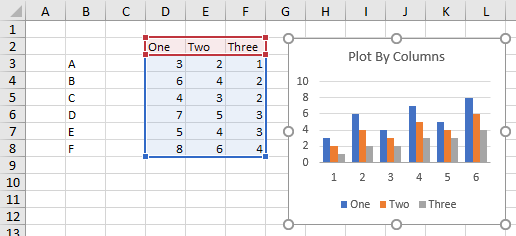
Let’s use the labels in B3:B8 for categories. Run the code: the InputBox is waiting for a range to be selected.
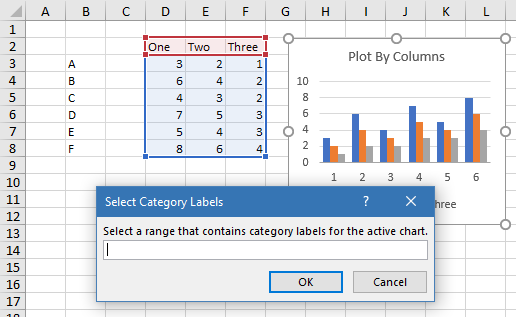
Select a range: it is highlighted with a dark dashed outline.
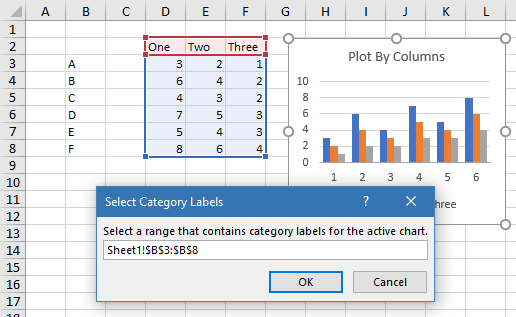
Click OK and the selected range is now highlighted as the category range, and the horizontal axis displays these labels as categories.
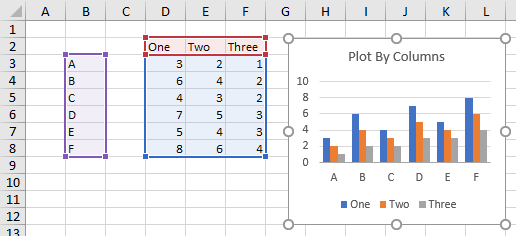
The above procedure can be used to assign categories (X values) for a chart that has none, or to replace the existing categories in a chart that already has them.
If the selected range has the wrong number of cells for the points in a series, the procedure tells the user to select a range with the right number of labels.
Find Range and Assign Series Names
If we construct a chart from an ideally-shaped range, there is a predictable alignment of X values, Y values, and series names in the worksheet. In this chart, the series data is in columns. The Y values for a series are in a vertical range, and the series name is in the cell directly above these Y values. The category labels (X values) are in the column to the left of the Y values of the first series.
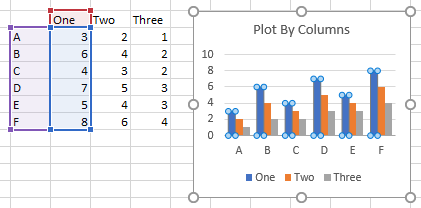
In the next chart, the series data is in rows. The Y values for a series are in a horizontal range, and the series name is in the cell directly to the left these Y values. The X values are in the row above the Y values of the first series.
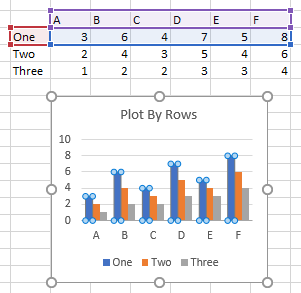
If for some reason the chart was constructed without series names or without category labels, but the missing elements are in the right alignment with respect to the Y values, we can find the cells with the series names or category labels and assign them to the chart.
Find Range and Assign Series Names
The procedure below processes each series in the active chart. First it looks up the SERIES formula, and extracts its arguments into an array. The code finds the address of the Y values, which is in the third argument, and locates the associated range. Then it determines whether the data is by column or by row, identifies the cell with the series name, and uses this cell’s address as the name of the series.
Sub FindAndApplyNamesToSeries()
If Not ActiveChart Is Nothing Then
With ActiveChart
Dim srs As Series
For Each srs In .SeriesCollection
' series formula
Dim sFmla As String
sFmla = srs.Formula
' just the arguments
sFmla = Mid$(Left$(sFmla, Len(sFmla) - 1), InStr(sFmla, "(") + 1)
' split into an array
Dim vFmla As Variant
vFmla = Split(sFmla, ",")
' Y values are the 3rd argument
Dim sYVals As String
sYVals = vFmla(LBound(vFmla) + 2)
' the Y value range
Dim rYVals As Range
Set rYVals = Range(sYVals)
' by row or column?
If rYVals.Rows.Count > 1 Then
' by column, so use cell above column of Y values
Dim rName As Range
Set rName = rYVals.Offset(-1).Resize(1)
ElseIf rYVals.Columns.Count > 1 Then
' by row, so use cell to left of Y values
Set rName = rYVals.Offset(, -1).Resize(, 1)
Else
' one cell only: who knows?
Set rName = Nothing
End If
If Not rName Is Nothing Then
srs.Name = "=" & rName.Address(, , , True)
End If
Next
End With
End If
End Sub
The data range for the chart below is intact, but somehow, the series names were not associated with it.
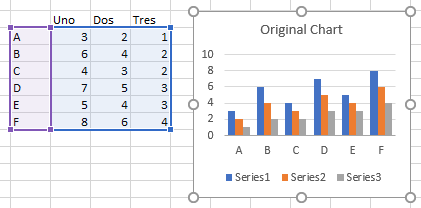
Select the chart and run the procedure, and it applies the series names.
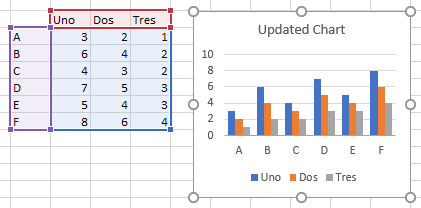
If the series in the chart already had names, this procedure overwrites those names with the names it finds in the worksheet.
Find Range and Assign Categories
The procedure below processes the first series in the active chart. First it looks up the SERIES formula, and extracts its arguments into an array. The code finds the address of the Y values, which is in the third argument, and locates the associated range. Then it determines whether the data is by column or by row, identifies the parallel range with the categories (X values), and uses this range as the categories for the first series, and therefore, for the chart.
Sub FindAndApplyCategoriesToChart()
If Not ActiveChart Is Nothing Then
With ActiveChart
Dim srs As Series
Set srs = .SeriesCollection(1)
' series formula
Dim sFmla As String
sFmla = srs.Formula
' just the arguments
sFmla = Mid$(Left$(sFmla, Len(sFmla) - 1), InStr(sFmla, "(") + 1)
' split into an array
Dim vFmla As Variant
vFmla = Split(sFmla, ",")
' Y values are the 3rd argument
Dim sYVals As String
sYVals = vFmla(LBound(vFmla) + 2)
' the Y value range
Dim rYVals As Range
Set rYVals = Range(sYVals)
' by row or column?
If rYVals.Rows.Count > 1 Then
' by column, so use column to left of Y values
Dim rXVals As Range
Set rXVals = rYVals.Offset(, -1)
ElseIf rYVals.Columns.Count > 1 Then
' by row, so use row above Y values
Set rXVals = rYVals.Offset(-1)
Else
' one cell only: who knows?
Set rXVals = Nothing
End If
If Not rXVals Is Nothing Then
srs.XValues = rXVals
End If
End With
End If
End Sub
The data range for the chart below is intact, but somehow, the categories were not attached to it.
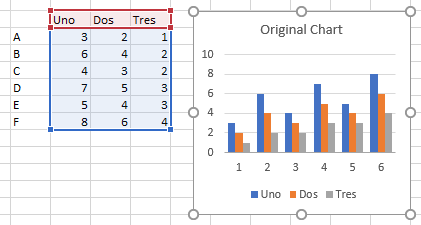
Select the chart and run the procedure, and it applies the categories to the chart.
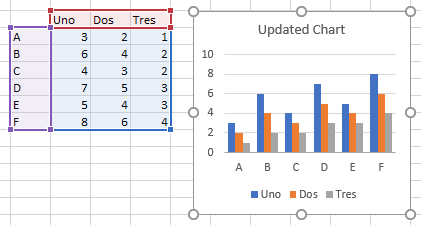
If the series in the chart already had categories, this procedure overwrites those categories with the new labels it finds in the worksheet.
Select Chart Source Data Range
For completeness, here is the routine that lets the user select the chart source data for the active chart.
Sub SelectChartSourceDataRange()
If ActiveChart Is Nothing Then
MsgBox "Select a chart and try again.", vbExclamation, "No Chart Selected"
Else
Dim Prompt As String
Prompt = "Select a range that contains source data for the active chart."
Dim Title As String
Title = "Select Chart Source Data Range"
Dim ChartSourceData As Range
On Error Resume Next
Set ChartSourceData = Application.InputBox(Prompt, Title, , , , , , 8)
On Error GoTo 0
If Not ChartSourceData Is Nothing Then
' if a range was selected
If ChartSourceData.Rows.Count >= ChartSourceData.Columns.Count Then
Dim DataOrientation As XlRowCol
DataOrientation = xlColumns
Else
DataOrientation = xlRows
End If
ActiveChart.SetSourceData ChartSourceData, DataOrientation
End If
End If
End Sub
Jon’s Toolbox
If you follow this blog closely, you may have heard of Jon’s Toolbox, a new Excel add-in that I released recently. I’ve already made a few changes to this utility, thanks to suggestions from readers like you.
Jon’s Toolbox already had a feature that made it easy to select a new source data range for a chart. While finishing up this article, I realized that these features should be included in the software.
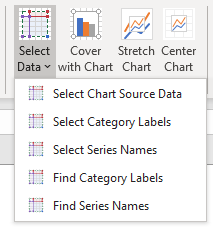
The features have only been added to the DEV version of the software on my computer, but in a week or so I will release a new build that includes these new functions. If you already have Jon’s Toolbox, subscribe to my newsletter to hear when the new build is live. If you don’t have Jon’s Toolbox, you can get it at the bottom of my article Jon’s Toolbox – A New Utility from Peltier Tech.




Yury Suturin says
HI Jon
Very nice article, as usual.
Wanted to add a comment about Application.InputBox usage. I very often switch to R1C1 calc mode for different reasons and when I run this type of code with default:= Selection.Address – and pressing ok- it obviously generates the A1 style address, so the error pops up. I deal with that via checking which ref style is used, storing the state, switching to A1 ref style in the beginning of the procedure and then switching back at the end.
Hope that may be useful and thanks one more time for awesome work! Please keep writing.
Jon Peltier says
Yury –
In my commercial add-ins, I have a routine that checks the inputbox text, and if it doesn’t reference a range, it tries converting between A1 and R1C1 to see if it returns a range
IvenBach says
Thank you for the article. Below were simple edits that once I started doing them cleaned up my code a lot.
You can replace the variable declarations `Dim Prompt As String` with `Const Prompt As String = “Select A Range”` (https://docs.microsoft.com/en-us/office/vba/Language/Reference/User-Interface-Help/const-statement), the same is true for `Title`. This can be done because the values aren’t changing. Ultimately though the variable/const could be replaced with the static value.
I’d like to suggest that that a `Const` also be used to replace `8` for the input box. `Const RangeReference As Long = 8` helps provide a meaning to what that magic number represents. Mention the documentation for the `Const` statement (https://docs.microsoft.com/en-us/office/vba/api/Excel.Application.InputBox#remarks), specifically the remarks section. Therein it explains other valid numeric values and what they represent.
Using named arguments (https://docs.microsoft.com/en-us/office/vba/language/glossary/vbe-glossary#named-argument) allows for removing unused commas. This shortens `Application.InputBox(Prompt, Title, , , , , , 8)` to `Application.InputBox(Prompt, Title, Type:=RangeReference)`.
Rather than have all the details in a single procedure break them up. Have each member (Sub/Function) do one thing. The topmost member calls smaller more specific members. Each specific member does only one thing.
“`
“`
Jon Peltier says
Iven –
Thank you for your suggestions. I’ve added links to Microsoft’s documentation for
MsgBoxand InputBox.I defined variables for Prompt and Title, because often I encapsulate InputBox in a function call, and I pass in these arguments. Your suggestion about naming a constant to use in place of the numeric constant 8 is well-taken, but Microsoft did not see fit to provide an enumeration for InputBox Types (which would have been the best situation), and I didn’t think of it.
You suggest that I encapsulate parts of my longer procedure. I often do this, and I indicated that encapsulation is one reason I use variables for Prompt and Title, rather than constants or even hard-coded arguments in the function calls. For a simple routine like this, for example, CanUpdateSeriesNames is a bit overboard, since it’s a simple one-line test whether I extract it or not, and the purpose of this post was to illustrate
Application.InputBoxand to share the idea of letting the user select a range and apply the range to their chart’s data.Peter says
“… in a week or so I will release a new build that includes these new functions.”
Did I miss an update or has this been delayed?
Jon Peltier says
Hi Peter –
Almost as soon as I wrote that, I had to prepare for some travel, so my plan to update the utility was delayed.
Now I’m back in town, and I’m behind on all of my regular work, so the utility is still delayed.
But it’s still on my radar!